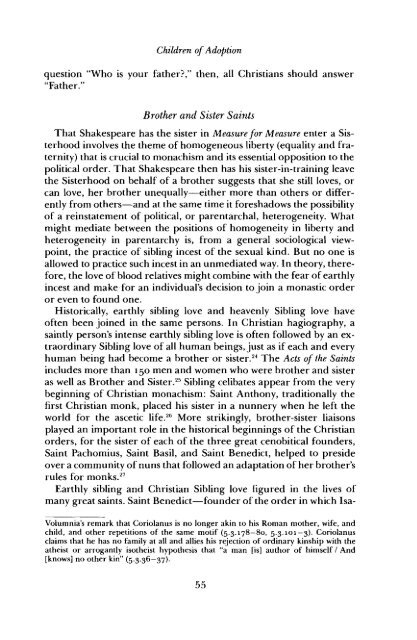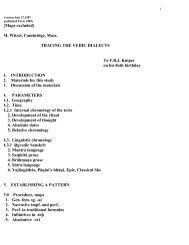Children of Adoption - People Fas Harvard
Children of Adoption - People Fas Harvard
Children of Adoption - People Fas Harvard
Create successful ePaper yourself
Turn your PDF publications into a flip-book with our unique Google optimized e-Paper software.
<strong>Children</strong> <strong>of</strong> <strong>Adoption</strong><br />
question "Who is your father?," then, all Christians should answer<br />
"Father."<br />
Brother and Sister Saints<br />
That Shakespeare has the sister in Measure for Measure enter a Sisterhood<br />
involves the theme <strong>of</strong> homogeneous liberty (equality and fraternity)<br />
that is crucial to monachism and its essential opposition to the<br />
political order. That Shakespeare then has his sister-in-training leave<br />
the Sisterhood on behalf <strong>of</strong> a brother suggests that she still loves, or<br />
can love, her brother unequally-either more than others or differently<br />
from others-and at the same time it foreshadows the possibility<br />
<strong>of</strong> a reinstatement <strong>of</strong> political, or parentarchal, heterogeneity. What<br />
might mediate between the positions <strong>of</strong> homogeneity in liberty and<br />
heterogeneity in parentarchy is, from a general sociological viewpoint,<br />
the practice <strong>of</strong> sibling incest <strong>of</strong> the sexual kind. But no one is<br />
allowed to practice such incest in an unmediated way. In theory, therefore,<br />
the love <strong>of</strong> blood relatives might combine with the fear <strong>of</strong> earthly<br />
incest and make for an individual's decision to join a monastic order<br />
or even to found one.<br />
Historically, earthly sibling love and heavenly Sibling love have<br />
<strong>of</strong>ten been joined in the same persons. In Christian hagiography, a<br />
saintly person's intense earthly sibling love is <strong>of</strong>ten followed by an extraordinary<br />
Sibling love <strong>of</strong> all human beings, just as if each and every<br />
human being had become a brother or si~ter.~The Acts <strong>of</strong> the Saints<br />
includes more than 150 men and women who were brother and sister<br />
as well as Brother and Sister.25 Sibling celibates appear from the very<br />
beginning <strong>of</strong> Christian monachism: Saint Anthony, traditionally the<br />
first Christian monk, placed his sister in a nunnery when he left the<br />
world for the ascetic life.2G More strikingly, brother-sister liaisons<br />
played an important role in the historical beginnings <strong>of</strong> the Christian<br />
orders, for the sister <strong>of</strong> each <strong>of</strong> the three great cenobitical founders,<br />
Saint Pachomius, Saint Basil, and Saint Benedict, helped to preside<br />
over a community <strong>of</strong> nuns that followed an adaptation <strong>of</strong> her brother's<br />
rules for monks.27<br />
Earthly sibling and Christian Sibling love figured in the lives <strong>of</strong><br />
many great saints. Saint Benedict-founder <strong>of</strong> the order in which Isa-<br />
Volumnia's remark that Coriolanus is no longer akin to his Roman mother, wife, and<br />
child, and other repetitions <strong>of</strong> the same motif (5.3.178-80, 5.3.101-3) Coriolanus<br />
claims that he has no family at all and allies his rejection <strong>of</strong> ordinary kinship with the<br />
atheist or arrogantly isotheist hypothesis that "a man [is] author <strong>of</strong> himself 1 And<br />
[knows] no other kin" (5.3.36-37).
















